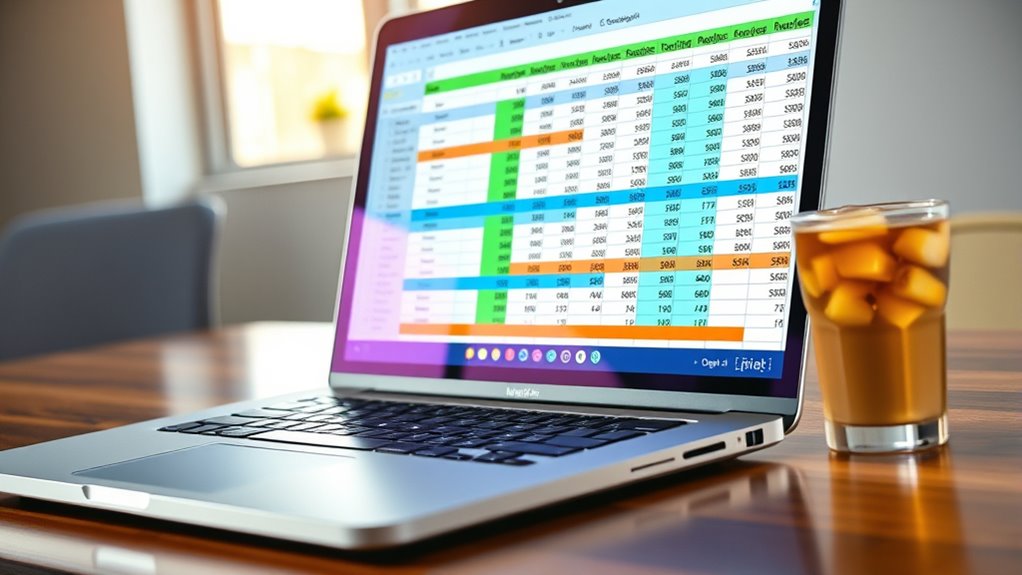To manage your beverage costs effectively, set up a detailed spreadsheet with categories like liquor, beer, wine, mixers, and garnishes. Log each purchase promptly, including date, supplier, and costs, and use formulas to track totals and percentages. Regularly update and analyze your data to spot high-cost items or waste. Staying consistent helps control expenses and improve profit margins. Keep exploring to discover more tips for maintaining a successful beverage cost system.
Key Takeaways
- Create detailed categories and columns for items, quantities, costs, and totals to organize beverage expenses effectively.
- Log each purchase immediately with precise details to ensure accurate tracking and data integrity.
- Use formulas to automatically calculate total costs and beverage cost percentage for real-time monitoring.
- Regularly analyze data to identify high-cost items, waste, and opportunities for cost savings and vendor negotiations.
- Maintain and update the spreadsheet consistently, scheduling reviews and incorporating inventory strategies for ongoing accuracy.
Setting Up Your Beverage Cost Spreadsheet
To effectively manage your beverage costs, you need a well-organized spreadsheet from the start. Begin by creating clear categories, such as liquor, beer, wine, mixers, and garnishes. Use separate columns for item names, quantities, unit costs, and total expenses. Set up formulas to automatically calculate totals and percentages, so you can quickly see how each category contributes to overall costs. Choose a consistent format for dates, prices, and quantities to avoid confusion. Incorporate color coding or bold headings to differentiate sections, making navigation easier. Make sure your spreadsheet is easy to update regularly—this foundation makes tracking and controlling costs much more straightforward later on. A structured setup guarantees you have a reliable tool for analyzing expenses and making informed decisions. Additionally, understanding cost control strategies can further enhance your ability to stay within budget.
Tracking and Recording Drink Purchases
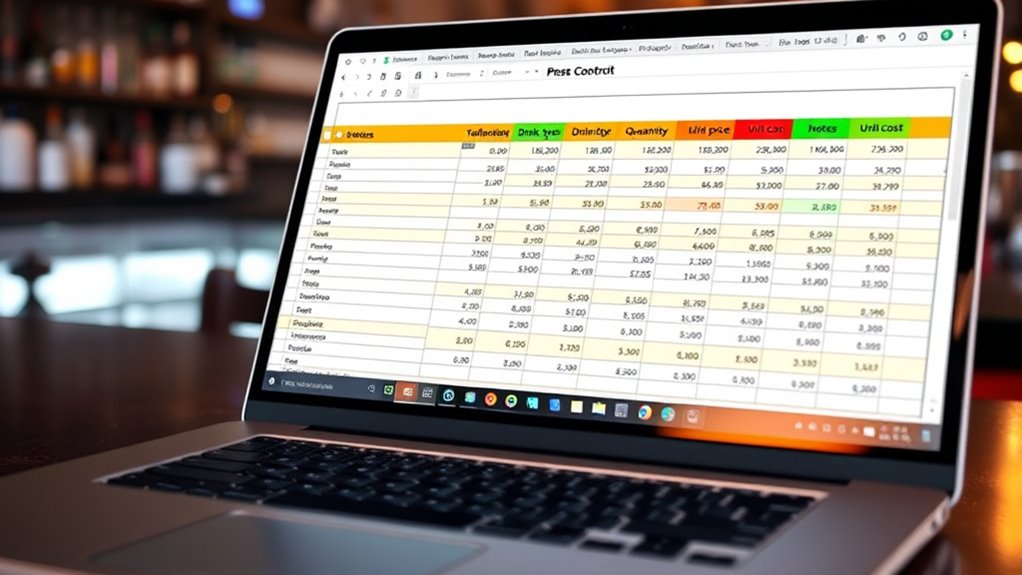
Once your beverage cost spreadsheet is set up, start focusing on accurately tracking and recording every drink purchase. You need to log each transaction immediately, capturing details like date, supplier, item, quantity, and cost. Use clear categories to organize your data, making it easier to review later. Consistency is key; always enter information the same way to avoid discrepancies. Double-check each entry for accuracy before saving. Keep receipts or purchase orders handy as references. Regularly updating your spreadsheet ensures you have real-time insight into your expenses. This process helps you identify patterns, spot overspending, and maintain control over your beverage costs. Accurate tracking is essential for making informed decisions and optimizing your overall beverage management. Incorporating proper tea brewing techniques can also contribute to better quality control in your beverage offerings.
Calculating Beverage Cost Percentage
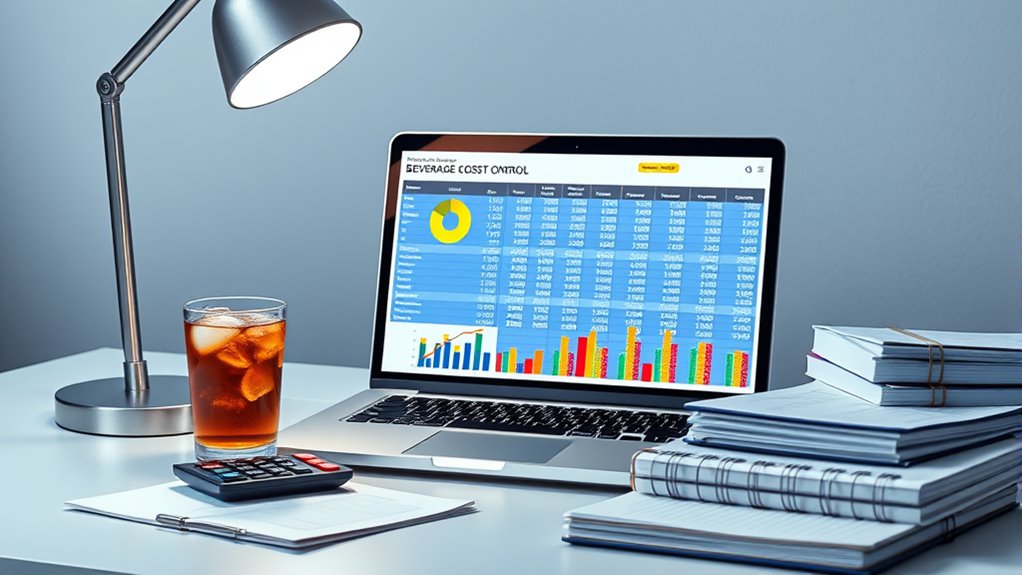
Understanding how to calculate your beverage cost percentage is essential for maintaining profitability. To do this, you divide your total beverage costs by your total beverage sales during a specific period. For example, if you spent $500 on beverages and sold $2,500 worth, your beverage cost percentage is 20% ($500 ÷ $2,500). This percentage tells you how much of your sales revenue goes toward beverage costs. Keeping this ratio low indicates efficient cost control, while a high percentage suggests you need to review purchasing or pricing strategies. Regularly calculating this figure helps you monitor trends and identify areas for improvement. Use your spreadsheet to input sales and cost data, and let it automatically compute your beverage cost percentage for quick, ongoing insights. Color accuracy in your beverage presentation can also influence perceived quality and customer satisfaction.
Analyzing Data to Identify Cost-Saving Opportunities
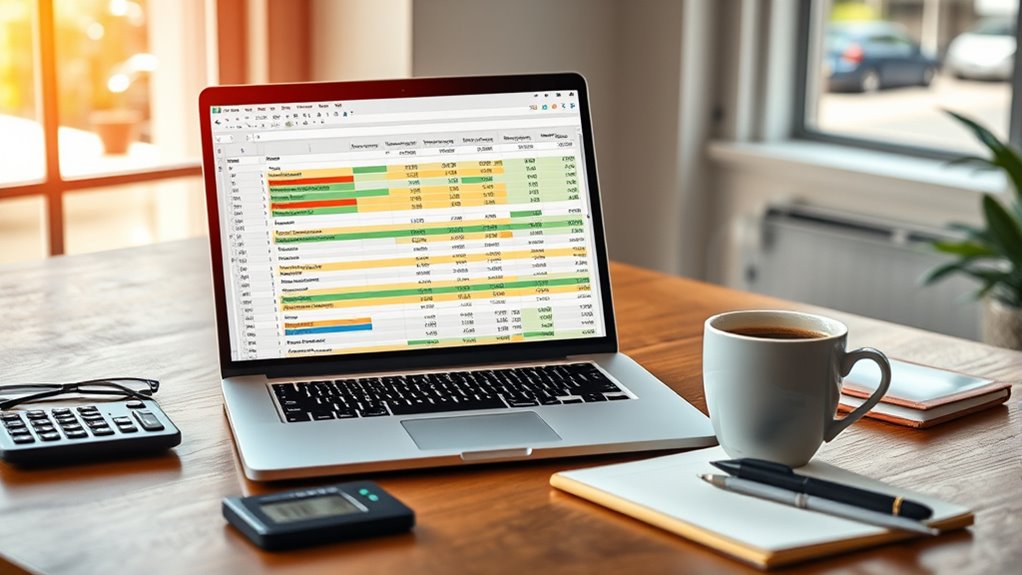
Analyzing your beverage cost data reveals patterns and opportunities that can lead to significant savings. Look for trends in high-cost items or times when waste increases. Compare your actual costs against your target benchmarks to identify discrepancies. Spot any over-pouring or theft by reviewing sales versus inventory data. Notice which suppliers offer the best prices and consider renegotiating contracts or switching vendors. Monitor sales fluctuations to adjust purchasing accordingly, avoiding excess stock. Evaluate portion sizes to prevent waste and ensure consistency. Recognize underperforming items that don’t generate enough profit and consider removing or replacing them. Regularly reviewing these insights helps you pinpoint where to cut costs without sacrificing quality, ultimately improving your beverage profit margins. Incorporating techniques from cost control strategies can further optimize your spending and enhance overall profitability.
Maintaining and Updating Your Spreadsheet for Ongoing Success
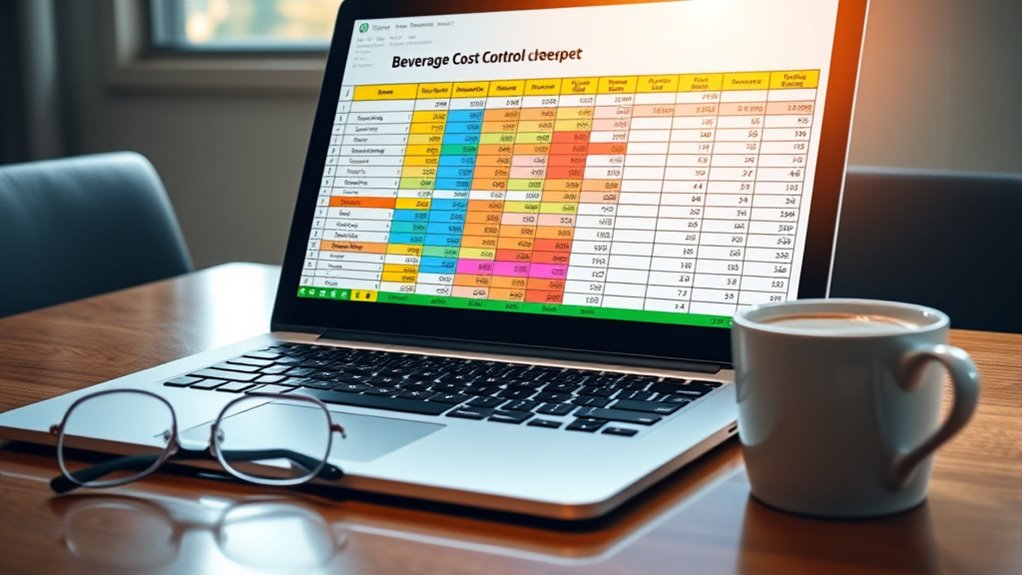
Keeping your beverage-cost control spreadsheet current is key to sustaining your savings and making informed decisions. Regular updates ensure your data reflects recent purchases, sales, and inventory changes. Set a schedule—daily, weekly, or after each shift—to review and input data. Check for errors or discrepancies to prevent skewed results. Also, update your formulas and categories as your operations evolve. Use the table below to track your maintenance tasks: hydrocolloid material can be incorporated into your inventory to help with product durability and effectiveness.
Frequently Asked Questions
How Often Should I Review My Beverage Cost Spreadsheet?
You should review your beverage cost spreadsheet regularly to keep costs in check and identify issues early. Ideally, do it weekly or biweekly, especially if your sales fluctuate or you’re managing a busy establishment. Consistent reviews help you spot discrepancies, track inventory, and adjust pricing or ordering strategies. Don’t wait too long; frequent checks guarantee your beverage costs stay controlled and your profit margins remain healthy.
What Software Is Best for Creating Beverage Cost Spreadsheets?
When choosing software for creating beverage cost spreadsheets, you want something user-friendly and reliable. Programs like Microsoft Excel and Google Sheets are popular because they offer customizable templates, formulas, and real-time collaboration. Excel is ideal for advanced features, while Google Sheets is great for sharing and cloud access. Both allow you to track costs efficiently, analyze data, and adjust your strategies to improve profitability.
How Do Seasonal Changes Affect Beverage Cost Management?
Seasonal changes impact your beverage cost management by altering supply costs and customer preferences. You need to adjust your budgets and inventory levels accordingly. Track price fluctuations and demand shifts regularly, so you can optimize ordering and minimize waste. By staying proactive and flexible, you guarantee your beverage costs stay manageable despite seasonal variations, maintaining profitability and customer satisfaction throughout the year.
Can I Integrate POS Data With My Spreadsheet?
Think of your POS data as the heartbeat of your business, pulsating with real-time insights. You can definitely integrate it into your spreadsheet to streamline beverage cost management. Use data export features from your POS system, then import or link these files directly into your spreadsheet. This way, you keep your finger on the pulse, ensuring accurate tracking and quicker adjustments, like a captain steering through calm and stormy waters alike.
What Common Errors Should I Avoid When Tracking Beverage Costs?
When tracking beverage costs, you need to watch out for common errors. Always double-check your data entry to prevent mistakes, and avoid using inconsistent units or prices. Don’t forget to update your inventory regularly, as outdated info skews your costs. Also, be cautious with portion sizes and waste tracking, since inaccuracies here can lead to incorrect cost calculations. Staying diligent prevents costly errors and keeps your beverage cost management on track.
Conclusion
By mastering your beverage‑cost control spreadsheet, you’ll minimize mistakes, maximize margins, and maintain manageable costs. Consistently tracking, tweaking, and taking time to analyze your data keeps your business thriving. Stay strategic, stay sharp, and never stop scrutinizing your sales and supplies. With dedication and detail, your drink costs decline, and your profits flourish. Keep this guide close, and watch your beverage business blossom beyond boundaries!
